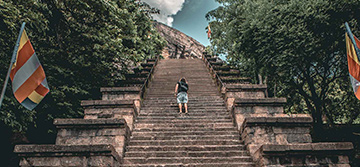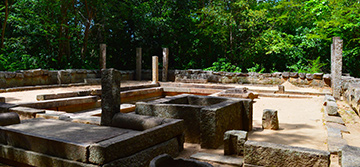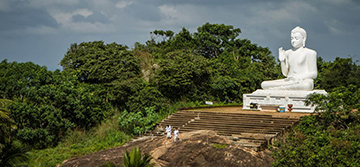Snapshot
Sri Lanka's Cultural Triangle has enthralled millions of travellers. It covers the north-central towns of Anuradhapura, Polonnaruwa, Sigiriya and Dambulla where extensive archaeological ruins, protected as World Heritage Sites, provide a glimpse into the island’s history. It is here that Sri Lanka’s kings developed remarkably advanced civilisations. The shimmering central plains have low rainfall and several hotels are sumptuous enough to provide a holiday in their own right.
Weather
The cultural triangle is largely situated within a dry zone. Apart from a high rainfall in November and December when the less-severe Maha monsoon hits the east coast, conditions remain fairly arid, although visitors during June and July may experience the hot, strong winds that help keep the south-western monsoon in the south and west at bay. Sri Lanka is affected by two separate monsoons which generally means that there is usually good weather somewhere on the island. Traditionally, the best time to visit the west and south coasts and hill country is from December to April, while the best weather on the east coast is from April/May to September.
Getting There
The cultural triangle can be reached directly from Colombo, although from the airport it may be advisable to head via back roads to Kurunegala, avoiding the main Kandy road at busiest times. The quickest way to Anuradhapura is beyond Negombo up the north-west coast. The route from Kandy takes you via Matale.
Highlights
- Gaze with wonder upon the ruins of Anuradhapura & Polonnaruwa
- Clamber up the giant rock fortress of Sigirya
- Discover Dambulla’s cave paintings and Buddha statues
- Watch the elephants in Minneriya
- Take a wooded walk through the ruins of Ritigala
- Cycle on peaceful minor roads by lakes and paddy fields
The ruins of Anuradhapura:
The ruins of Anuradhapura, the country's first capital includes a large number of sacred Buddhist sites including dagobas, monasteries, palaces and the ancient Bo Tree, grown from the original tree under which Lord Buddha attained enlightenment.
Aukana Buddha:
One of Sri Lanka’s most perfect and elegant statues, the Aukana Buddha lies to the west of Kala Wewa. The statue stands 12m high, carved from a single rock and is completely free-standing.
Dambulla’s ancient cave temple:
Dambulla’s ancient cave temple has a rock ceiling with a sweep of colourful frescoes, some of which date back to over 2,000 years, depicting Buddhist mythology and the tales of the Buddha's previous births
Mihintale:
Mihintale, where Buddhism originated on the island in 247 BC is especially inspiring on a Full Moon Poya Day when hundreds of people congregate in silent prayer, the statues are surrounded with flowers and the air is scented with incense and burning oils. Vesak takes place on full moon day in May with remembrance of Lord Buddha’s birth, enlightenment and Prinivanpama (his passing). In June, the festival of Poson is celebrated in remembrance of the introduction of Buddhism to Sri Lanka by Mahinda.
Polonnaruwa:
Polonnaruwa’s ruins include the magnificent sculptures of Lord Buddha at the Gal Vihara cut into Granite stone. The archeological museum in Polonnaruwa provides a useful guide to this ancient kingdom
The Ritigala Buddhist Monastery:
The Ritigala Buddhist Monastery nestles deep inside the Ritigala Nature Reserve. Walking up wooded slopes to the beautiful ruins, it is easy to imagine yourself as Indiana Jones whilst clambering over the overgrown relics of a forgotten time.
Sigiriya:
Sigiriya is one of the most dramatic historical sites in the world. A mythical past of feuding dynasties enhances Sigiriya’s striking setting, which was built in 5C by King Kasyapa as a rock fortress. Worthy of being called the “8th wonder of the world”, Sigiriya will astonish with its beautiful views and staggering engineering.
Wilpattu National Park:
Tantirimale borders Wilpattu National Park. A gradual climb leads to acres of flat granite rock where there are several ancient statues of Lord Buddha carved out of the rock, a dagoba and Bo tree. Secluded and little visited with great views.
Yapahuwa:
After the fall of Polonnaruwa, the Kandyan kings fled to a succession of inaccessible crags, bearing the sacred tooth relic of the Buddha. One of them was Yapahuwa, where you can climb steep steps to the ruins.
The Cultural Triangle is found on Sri Lanka’s central plains and encompasses Anuradhapura, Polonnaruwa, Sigiriya, and Dambulla. It is here that the country’s kings gave rise to a great civilization based on agriculture and Buddhism.
These kings also treasured the ancient healing wisdom of Ayurveda, which remains preferred health care in rural areas as well as forming a centrepiece of many holidays.
Anuradhapura, Sri Lanka’s first capital, was the greatest monastic city of the ancient world and was ruled from the 4C BC to 11C AD by more than 100 Sri Lankan kings. Polonnaruwa became Sri Lanka’s royal medieval capital in 1073 where the Sinhalese king Vijayabahu I followed by Parakramabahu I, ruled. It remained Sri Lanka’s capital until the late 13C.
Another significant event in Sri Lanka’s history is the introduction of Buddhism to this island in 247 BC: Mihintale is especially inspiring on a full-moon day.
Water Garden
Serves delicious international cuisine (Indigaswewa, Sigiriya, 0664 933 000)
Jetwing Vil Uyana
The most popular restaurant in Sigiriya, serving a selection of Western, Asian and authentic Sri Lankan cuisine (0662 286 000)
Heritance Kandalama
International cuisine and spectacular views across Kandalama Lake (0665 555 050)
Ulagalla
This cosy dining venue offers you the best of Sri Lankan, Asian and Western cuisine as well as unique fusion fare (Thirappane, 0252 050 280)
Forest Rock Garden
Serves (only) authentic vegetarian cuisine (Puttalam Road, Andarawewa, 0252 033 000)
The Lake
Serves a selection of Western, Asian and Sri Lankan food overlooking a magnificent lake (New Town, 0272 222 411)
Deer Park Hotel
Serves a selection of Western, Asian and Sri Lankan dishes (Giritale, 0272 246 272)
Popular Activities
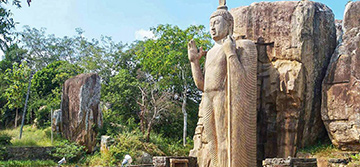
The Aukana Buddha
Dambulla, Sri Lanka
One of the most spectacular statues in Sri Lanka, the Aukana Buddha has stood 12m high since it was made in the 5th century. It is free-standing, carved from a single rock.
Duration: 1 hour
Best time: Year-round
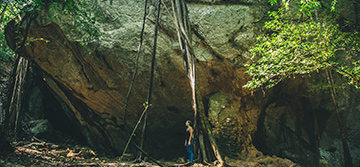
Kaludiya Pokuna
Kandalama, Sri Lanka
Trek through the tranquil Kaludiya Pokuna Forest near Kandalama in search of a ruined ancient Buddhist temple abandoned over 1,200 years ago. Absorb the peaceful atmosphere.
Duration: 3 hours
Best time: Year-round
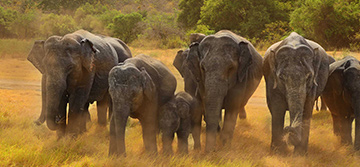
Wasgamuwa National Park
Wasgamuwa National Park, Sri Lanka
Wasgamuwa National Park is comprised of dry evergreen forests, grasslands and wetlands, and is known for the elephants which frequent the Mahaweli River which runs along a boundary of the park.
Duration: 3 hours
Best time: November to May
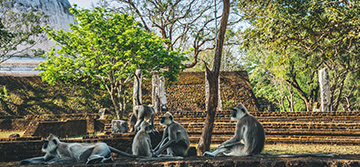
The Monkey Kingdom of Polonnaruwa
Polonnaruwa, Sri Lanka
Quite apart from the incredible ruins of this medieval city, Polonnaruwa is home to a large monkey population who were famously featured in Disney’s engaging documentary film ‘Monkey Kingdom’.
Duration: 3 hours
Best time: Year-round
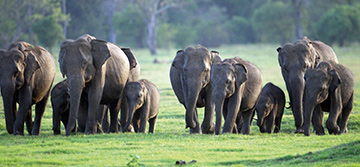
Minneriya National Park
Minneriya National Park, Maradankadawala-Habarana-Thirukkondaiadimadu Highway, Rambawilla, Sri Lanka
Minneriya National Park is a small but popular wildlife park home to a wide range of Sri Lanka’s wildlife. It is also the site of the world-renowned wildlife event ‘The Elephant Gathering’.
Duration: 1 hour
Best time: July to December

Sri Lanka Hot Air Ballooning
Kandalama, Sri Lanka
Rise at dawn and soar above the wide plains and clusters of jungle which cover the Cultural Triangle, an area of Sri Lanka which is littered with dramatic ancient ruins dating back over 2,000 years.
Duration: 3 hours
Best time: November to April
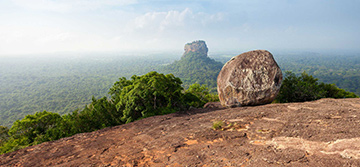
Pidurangala Rock
Pidurangala Rock, Sigiriya, Sri Lanka
Whilst building Sigiriya Rock Fortress in the 5th century AD, King Kasyapa moved the monks who lived around Sigiriya to Pidurangala Rock, and an ancient cave temple still remains here.
Duration: 3 hours
Best time: Year-round
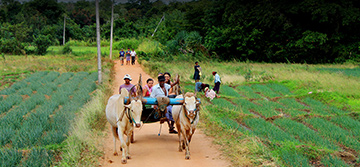
Traditional Sri Lankan Village Life
Sigiriya, Sri Lanka
Hop into a bullock cart and explore the village life of the island. Walk through lush paddy fields, take a boat ride along Hiriwaduna Wewa and finally, savour a traditional Sri Lankan meal to wrap up your sojourn in the village.
Duration: 2 hours
Best time: Year-round
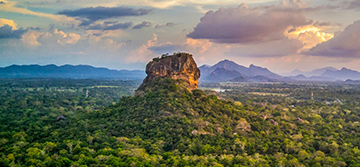
Sigiriya Rock Fortress
Sigiriya Rock Fortress, Rock Front, Sigiriya, Sri Lanka
Sigiriya, a UNESCO World Heritage Site, is one of the most majestic, awe-inspiring and stunning historical locations in the world, built in the 5th century AD by ‘mad’ King Kasyapa.
Duration: 3 hours
Best time: Year-round
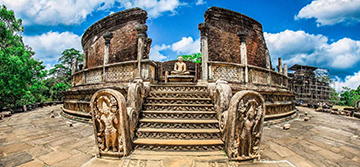
Polonnaruwa
Polonnaruwa, Sri Lanka
Sri Lanka’s medieval capital from 1073 until the late 1200s, the ruins of the Kingdom of Polonnaruwa are incredibly well-preserved and include magnificant granite sculptures of Lord Buddha.
Duration: 2 hours
Best time: Year-round
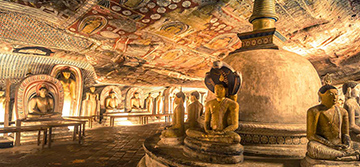
Dambulla Cave Temple
Dambulla Cave Temple, Kandy - Jaffna Highway, Dambulla, Sri Lanka
The most famous cave temple complex in Sri Lanka, the ancient Dambulla Cave Temple boasts the largest number of Buddha statues to be housed in one place, as well as stunning ceiling paintings.
Duration: 1 hour
Best time: Year-round
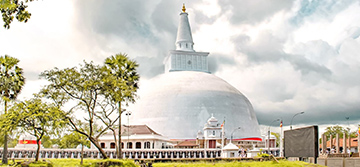
Anuradhapura
Anuradhapura, Sri Lanka
Discover the majestic remains of Sri Lanka’s first capital, originally built in the 4th century BC, the ruling place for over 100 Sri Lankan kings. You can explore these extensive ruins by bike.
Duration: 3 hours
Best time: Year-round
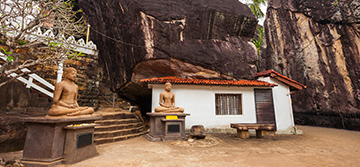
Aluvihara Cave Temple
Aluviharaya Rock Cave Temple, Sri Lanka
Aluvihara Cave Temple, which can be visited easily from Kandy and the Cultural Triangle, is where the oral teachings of Lord Buddha were first put into writing in the 3rd century AD.
Duration: 1 hour
Best time: Year-round













